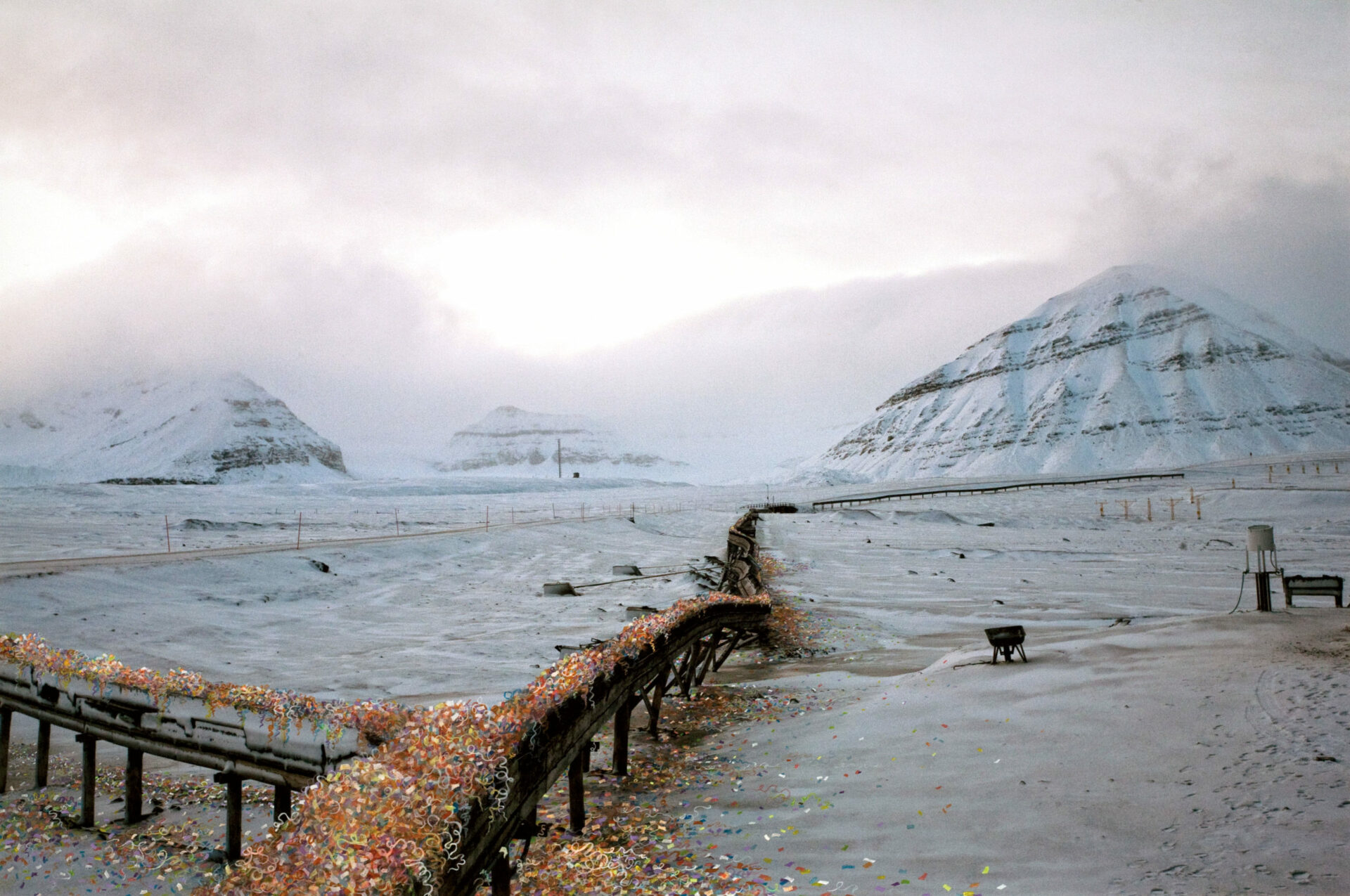01. Questions, critical analysis, and a desire to do otherwise. Alternative knowledge economies are often triggered into being through acts of collaboration. The singular is pluralized and tempered through free association. Can some of anarchism’s possibilities seep into the halls of learning?. . . Sans Titre / Untitled. Sophie Bélair Clément et David Tomas en conversation. Image à l’arrière-plan de l’affiche annonçant la conférence ICI (Intervenants Culturels Internationaux) du 1er avril 2010, UQAM, RM-130, 12 h 30. Conférence annulée en appui à la grève étudiante.
02. The passage of the body through different architectural forms and strata is an important everyday experience. Stairways (also known as steps, stairs, or staircases) are some of the most important material and symbolic gateways to, from, and within architecturally defined configurations of power and knowledge. Why has no one written a symbolic anthropology of that fundamental interstitial transitional space: the stairway? Lecture to an Academy. Performers: David Tomas, Penny Farfan. Performed at the theatre of the National Research Council, Ottawa on May 4, 1986 during the exhibition Songs of Experience. Photo credit: Charles Hupé, National Gallery Photographic Services. The National Gallery of Canada, Ottawa. On Her Majesty’s Service.
03. De : Penny Farfan Objet : Rép. : 1986 Date : 1er avril 2011 14:47:23 HAE Dear Sophie (and Dave), I was not involved in the conceptualization of Lecture to an Academy, only in the performance. I was an actor at that time and someone connected me with David Tomas, who was looking for a performer to read the ape/woman part in the performance. You probably already know that the piece was actually staged three times: first in an old lecture theatre in the Redpath Museum at McGill University in 1985; next, in the Art Department at York University, also in 1985; the 1986 performance at the National Research Council that you are studying was actually the third presentation. The major change between the three versions was the performance space: the texts and audio, as I recall, remained the same. . . . In case you haven’t already seen them, I’ve attached two photographs of the performance at the Redpath that may be of interest to you. You will see in these documents that it was a more intimate performance space than the lecture hall at the NRC in 1986. You will also see that it was a small audience. I hope these few details will be of interest/use to you. Best wishes for your research.
04. 15 septembre 2012 16:34. Auditorium du musée Redpath. Photo SBC. History is the only coherent basis for change because it provides a comparative backdrop for contemporary action. Thus it has always been of critical importance to preserve important symbols of the past. I remember as a boy visiting the Redpath Museum and being fascinated with its eclectic natural history collections and odd objects like an Egyptian mummy (?); while at home I used to play with my toys (cars, etc.) on a Chinese carpet whose layout evoked an ocean surrounded by a roadway and, if my memory serves me well, images that could double as villages. . . . (David Graeber: “The role of the imagination as a political principle. . .”). It is of no surprise, therefore, that while I chose to pursue anthropological research at McGill, I would present Lecture to an Academy at the Redpath Museum’s lecture room. Can one imagine an educational process that was configured as a form of outsider art?
05. Lecture to an Academy. Conférenciers/Lecturers: Penny Farfan / David Tomas. Montreal, McGill University. Auditorium du musée Redpath, 6 février, 19 h. Toronto York University Department of Fine Arts, March 7th 5:00 PM. 1985. Poster/flyer with photograph by Angela Grauerholz.
06. Communiqué distribué lors de la conférence ICI (Intervenants Culturels Internationaux). Après Lecture to an Academy (After Franz Kafka), 1985-1986. UQAM, AM-0506, 6 avril 2011, 12 h 40. Signé R.P.

01-06. 2 rooms equal size, 1 empty, with secretary,(1). Du 27 septembre 2012 au 26 janvier 2013. Raphaël Huppé Alvarez, Vincent Bonin, Marie Claire Forté et David Tomas ont accepté de participer à une exposition organisée par Sophie Bélair Clément, qui a accepté l’invitation du commissaire Eduardo Ralickas. (1) « Plan général de la galerie. Deux pièces de superficie égale, l’une étant vide, avec secrétaire, téléphone, bureau, meuble de classement et catalogue. L’autre contenant deux œuvres de chaque artiste. » Seth Siegelaub, livre des visiteurs et notes préparatoires, I.A.43, January 5-31, 1969 [le January Show], archives du Museum of Modern Art, New York. Photos 01, 02, 04 de Paul Litherland, avec la permission d’Artexte, 2012. Photo 03 de SBC, 05 de Marie Claire Forté, 06 de DT. Plan au sol.
Absent. Writing is an impossible task
Only artists. A bringing together (last night, I added one to the list). Some, I know very well, some a little, others not at all, or differently. A constellation. This one holds together well: a community of ideas before and during reification (or in its absence). An economy of ideas that circulate. There are emotional ties.
Sophie Bélair Clément, David Tomas, Marie-Claire Forté, Adrian Piper, Maria Eichhorn, Knowles Eddy Knowles, Maria Gilissen, Marcel Broodthaers, Silvia Kolbowski, René Magritte, Julie Ault, Tris Vonna-Michell . . .
The images: Where does an artist’s work begin or end? Where is the space of art located? What form does it take? Silvia Kolbowski titles her blog the work behind the artwork.
On her blog, Silvia speaks of Marcel Broodthaers (and Buchloh and Apollinaire) — a recently published collection of his writings — and his invitation-statement for his very first exhibition in 1964: “I, too,wondered if I couldn’t sell something and succeed in life . . . .” She speaks of “accommodation” and within this term of the notion of “giving consideration to.” Broodthaers, in his passage from poet to artist, and Apollinaire in his invention of the calligramme, registered, each in their own way, the social transformations that had taken place at that moment. There is a process of “giving consideration to, a giving space to, of fitting something in.” Their work took its form in the distance that the act of “consideration” conferred on their practice.
I invited Sophie who invited David and the others appeared, they were there. Others were added. But there are also books, sites, projects, exhibitions, history, exchanges, travels, conversations. MT
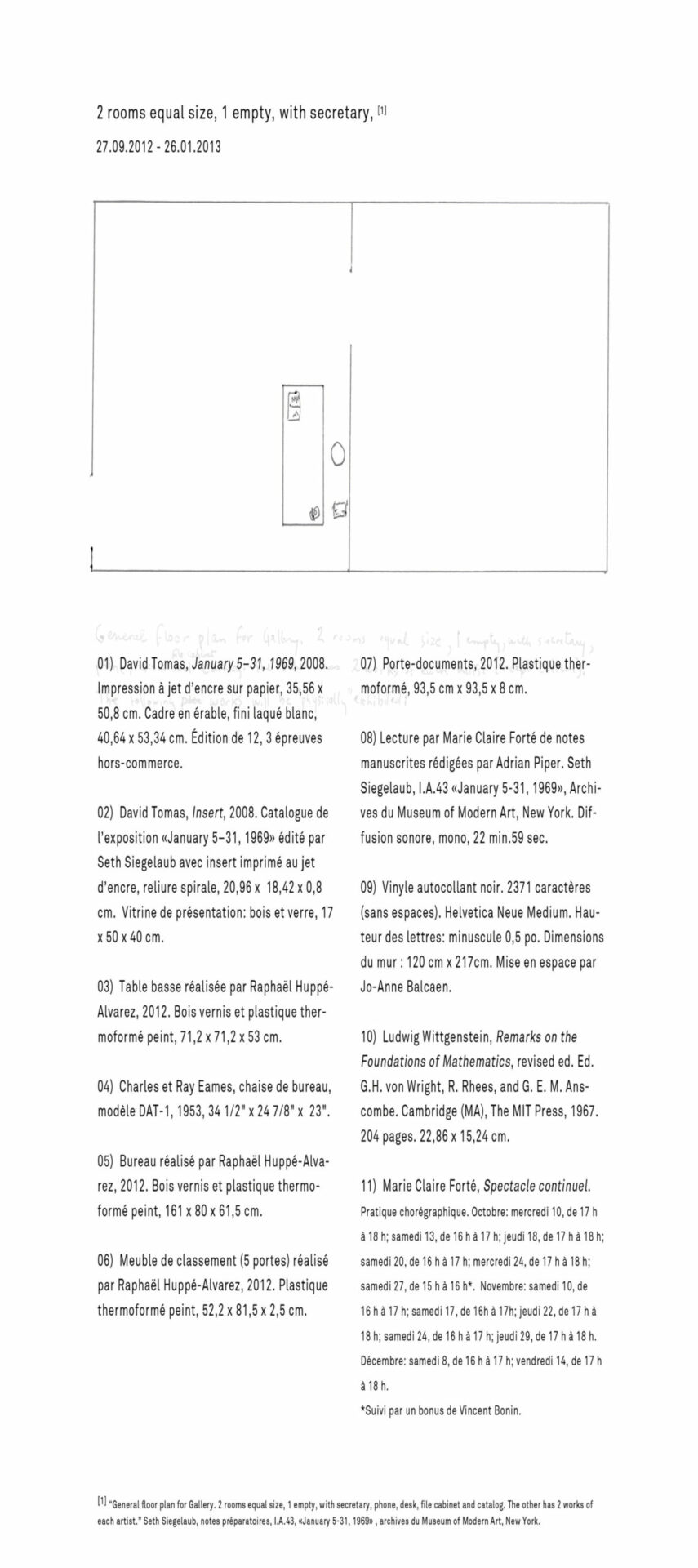
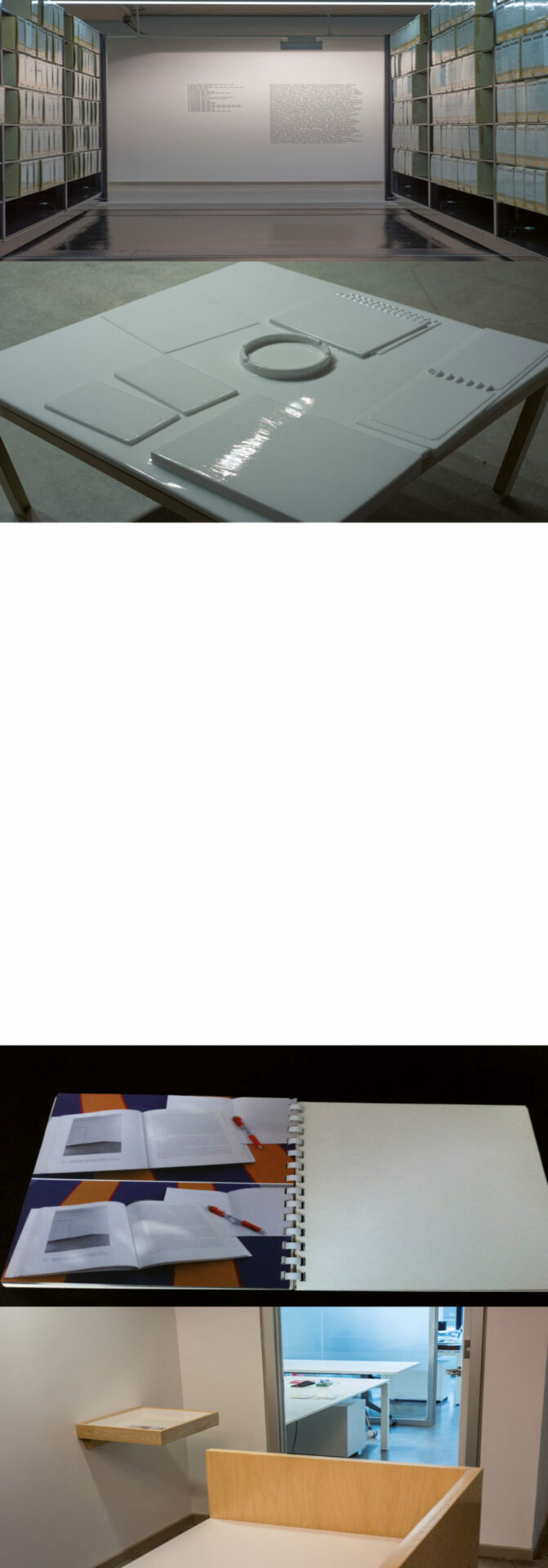
01. 2 rooms equal size, 1 empty, with secretary,(1) (livre des visiteurs). Vinyle autocollant noir. 2371 caractères (sans espaces). Mise en espace par Jo-Anne Balcaen. Photo : Paul Litherland, avec la permission d’Artexte, 2012.
02. De : APRAF Berlin (Director) Date : 16 juillet 2012 03:40 Objet : Adrian Piper, January 5-31, 1969 Regarding visitors, the only one I remember other than the ones you would expect (Sol LeWitt, Christine Koslov, Mel Bochner, Ian Wilson, etc.) was Donald Barthelme, Rick Barthelme’s brother, because I had read several of Donald’s books. . . . However, once Christine noticed that I was reading Wittgenstein’s Remarks on the Foundations of Mathematics, and she drew Joseph’s attention to this because they had not realized it was out. Photo : Paul Litherland, avec la permission d’Artexte, 2012.
03. DT, Insert, 2008. Catalogue de l’exposition January 5-31, 1969 édité par Seth Siegelaub avec insert imprimé au jet d’encre, reliure spirale, 20,96 x 18,42 x 0,8 cm. (The double and its “other.”) 04. DT, Insert, 2008. Photo : Paul Litherland, avec la permission d’Artexte, 2012. Insert installed on the margins of 2 rooms equal size, 1 empty, with secretary,(1). A long time ago I had an interesting conversation with another artist on the question of how spectators navigate installations and the things they see and don’t see. There is no such thing as an absolute exhibition experience. Lacunas are as important as what has been seen. The same is true of an insert. It too represents a kind of lacuna in the original, but in this case, the concretization of a certain evolutionary trajectory where the insert serves to mark a possible future. The concretization of another possible future was represented by 2 rooms equal size, 1 empty, with secretary,(1).
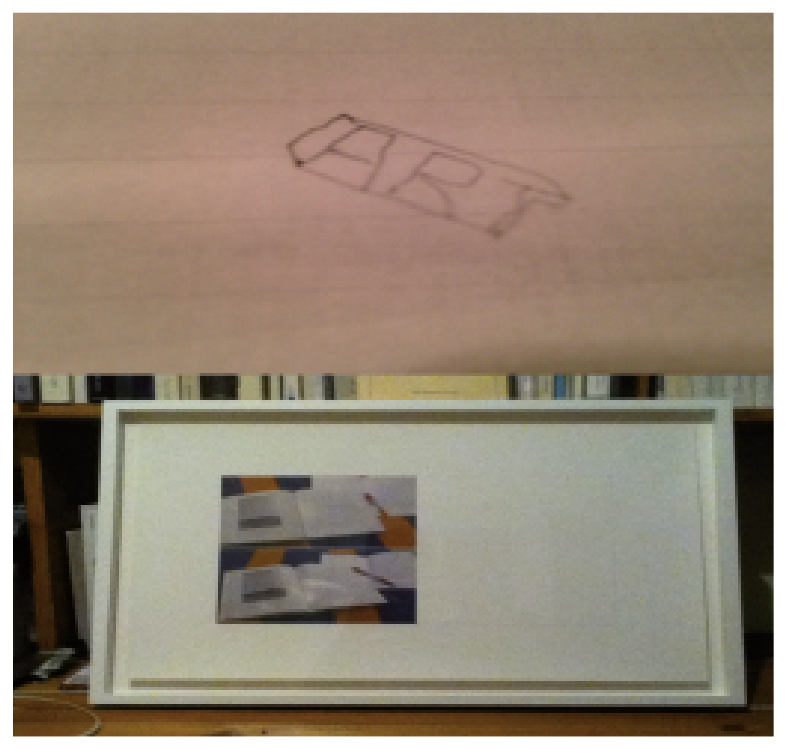

01. Le 14 janvier, 30 visiteurs, dont un groupe d’étudiants, passent voir l’exposition January 5-31, 1969 organisée par Seth Siegelaub. Lucy Lippard téléphone sans laisser de message. Adrian Piper, à la réception, compose Text of a piece for Larry Weiner. Medium tape recording (lenght 600’ @ 7 1/2 IPS). Du mois d’octobre au mois de décembre 2012, Marie Claire Forté présente une pratique chorégraphique, un spectacle continuel dans la salle de réunion d’Artexte. Pendant le Spectacle Continuel, MCF diffuse l’enregistrement audio de sa lecture de Text of a piece for Larry Weiner et en fait la traduction simultanée. [Détail d’une feuille de notes, archives du Museum of Modern Art, Seth Siegelaub, I.A.44.]
02. Œuvre de DT, donnée à SBC, prêtée à VB. Photo : Vincent Bonin.
03. L’étiquette derrière l’œuvre indique Maria Gilissen b.1939 René Magritte and Marcel Broodthaers, 1966. Two gelatin silver prints. Each approximately 11 1/4 x 7 1/2 in. (28,6 x 19,1 cm). Each with credit stamps on the verso. J’ai rencontré M. Gilissen rue Waterloo le 29 mai dernier. Elle m’a parlé des bibliothèques de M. Broodthaers et de R. Magritte.
04. Lot 245, Maria Gilissen, 1) René Magritte, 2) Marcel Broodthaers, 1966. Collection of Corbeau et Renard, New York, New York, Wednesday, April 09, 2008. Private collection.
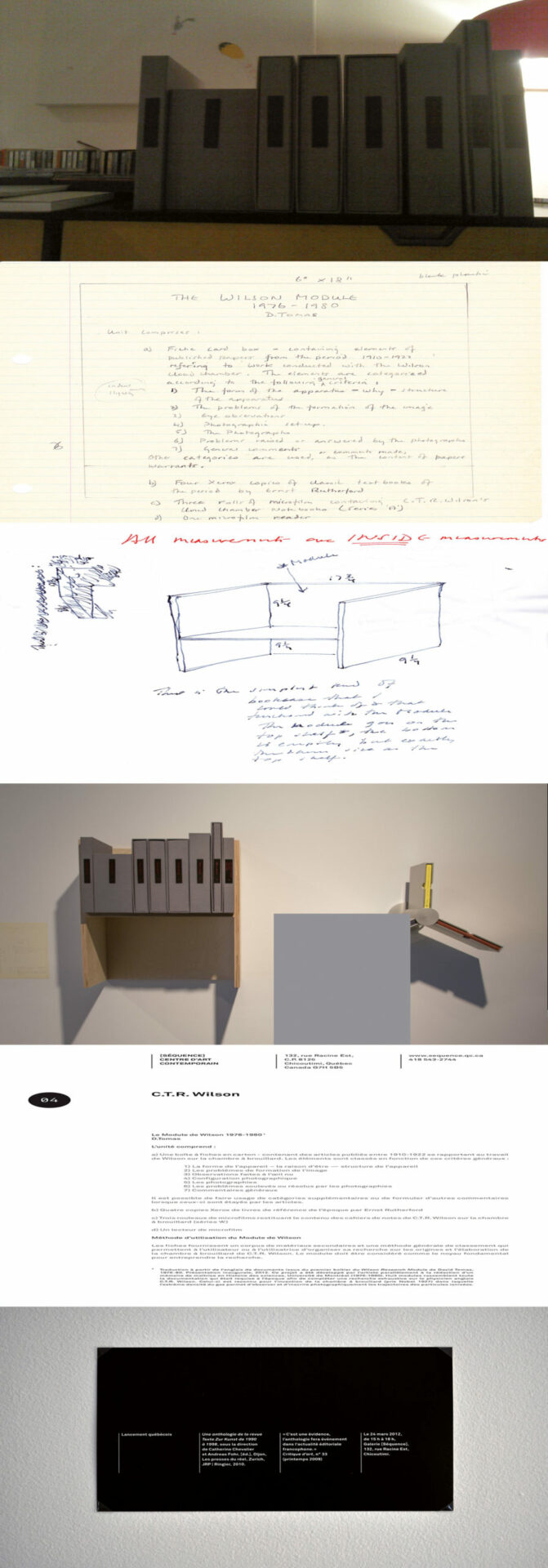
01. DT, The Wilson Module 1976–80. Photo: SBC. Lately, there has been much talk of “Theory” and “Research” in relation to recent developments in contemporary art. Has it taken place in an ethereal context of collective ignorance? What is the role of the academy and its disciplines in its cultivation and the encouragement of a form of historical myopia? How many people feel marginalized within their educational process, and why is this the case? The Wilson Module was a prototype for a mobile, post-academic artifact/experience: it embodied in embryotic form the concept of transdisciplinary research module (TRM) for an alternative knowledge society. It is important to imagine a different form of library (and not just a digital alternative), beginning with the bookcase. (Note the slight but significant resonance between bookcase and staircase. . .) A return to “real” space is more than just a simple political act — it is an epistemo-political one.
02. De : David Tomas Objet : Rép : présentation Date : 11 février 2012 12:34:28 HNE Here are the pdfs of the Wilson instructions: Lots of fun last night. . . . (you forget Frankenstein here . . .)
03. De : David Tomas Objet : WILSON MODULE DIAGRAM Date : 14 février 2012 15:05:31 HNE Here is the diagram — its not to scale so it looks square and high, but in fact it’s more like a rectangle. It’s designed so that the books-elements, etc. are free at the top and go beyond the bookcase’s containing walls. This way, the module conserves its architectural/knowledge form. . . . When hung on the wall it functions as a bookcase and architectural structure (I hope). . . . Ideally it would have to be built of aluminum (like my other bookcase) — I’ve asked for an estimate. . . . It could also be built in plywood (Russian???) — for your show. . . .
04. Présentation inaugurale : David Tomas, The Wilson Module, 1976-1980 (à gauche). Photocopies, microfilms, transcriptions manuscrites. Ce projet a été développé par l’artiste parallèlement à la rédaction d’un mémoire de maitrise en histoire des sciences, Université de Montréal, entre 1976 et 1980. Il est composé de huit modules regroupant la documentation qui était requise à l’époque afin de compléter une recherche exhaustive sur le physicien anglais C.T.R. Wilson. / David Tomas, Prototype for a TRM (Transdisciplinary Research Module), 2009 (à droite). Vue de l’exposition et al., [Séquence] centre d’art contemporain, Chicoutimi, 24.03.12-13.05.12. Copie d’écran erronée.
05. Communiqué de presse (4e d’une série de 7) envoyé aux membres de la galerie [Séquence] dans le cadre de l’exposition et al. Traduction à partir de l’anglais de documents issus du premier boitier de The Wilson Module de David Tomas, 1976-1980. C.T.R. Wilson. L’unité comprend : a) Une boite en carton – contenant des éléments de communications publiées entre 1910 et 1922 en référence au travail de Wilson sur la chambre à brouillard. Les éléments sont classés en fonction des critères généraux suivants : 1) Forme de l’appareil – raison – structure de l’appareil 2) Problèmes de formation de l’image 3) Observations 4) Configuration photographique 5) Photographies 6) Problèmes soulevés ou résolus par les photographies 7) Commentaires généraux. D’autres catégories sont utilisées, ou commentaires formulés, selon le contenu des mandats papier. b) Quatre copies Xerox de textes classiques de l’époque par Ernest Rutherford. c) Trois rouleaux de microfilms contenant les cahiers de notes de C.T.R. Wilson au sujet de la chambre à brouillard (séries ‘A’). d) Un lecteur de microfilm. Méthode d’utilisation du Module de Wilson Les fiches fournissent un corpus de matériel secondaire ainsi qu’une méthode générale de classement qui permettent à l’utilisateur ou à l’utilisatrice d’organiser sa recherche au sujet des origines et des développements de la chambre à brouillard de C.T.R. Wilson. Le module doit être considéré en tant que noyau fondamental autour duquel la recherche peut être menée.
06. Vincent Bonin. Lancement québécois. Une anthologie de la revue Texte Zur Kunst de 1990 à 1998, sous la direction de Catherine Chevalier et Andreas Fohr [éd.], Dijon, Les presses du réel, Zurich, JRP|Ringier, 2010. « C’est une évidence, l’anthologie fera événement dans l’actualité éditoriale francophone. » Critique d’art, n° 33 (printemps 2009). Le 24 mars 2012, de 15 h à 18 h, galerie [Séquence], 132, rue Racine Est, Chicoutimi. Cartons d’invitation, 15 anthologies, projection vidéo HD, 20 min.
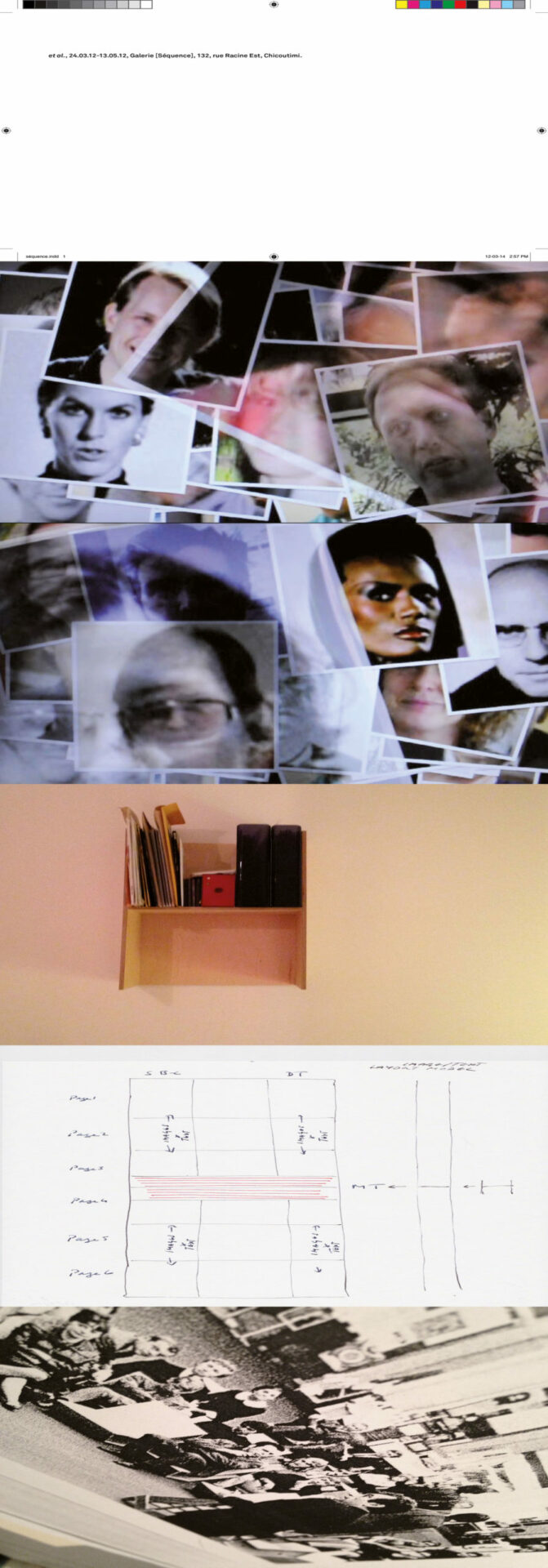
01. et al. 24.03.12-13.05.12, exposition organisée par Sophie Bélair Clément et Vincent Bonin avec Maria Eichhorn, Knowles Eddy Knowles, David Tomas et al., carton d’invitation (verso). Graphisme : Simon Guibord.
02-03. Écran de veille (conversations téléphoniques avec Vincent Bonin, 23.08.2011-13.03.2012), 2012. Projection vidéo dans la vitrine hors des heures d’ouverture de [Séquence]. et al. 24.03.12-13.05.12.
04. Il manquait un centimètre au premier dispositif fabriqué, alors je l’ai gardé. [Contents of Bookcase: Fareed Armaly, brea-kd-own, Palais des Beaux-Arts de Bruxelles, 1993 ; Contrat pour la préservation des droits de l’artiste sur toute œuvre cédée (Siegelaub+Projansky) ; Christopher Williams – communiqués de presse, archives de Jean-Noël Herlin, documents achetés conjointement avec Vincent Bonin, 2012 ; photocopies, catalogues de Prospect 68 et Prospect 69 (archives MBAC) ; photocopies, catalogue March 1969, Seth Siegelaub (archives MBAC) ; photocopies, occupation de l’été 1968, archives du Palais des Beaux-Arts, Bruxelles ; photocopies, fonds Seth Siegelaub, archives du Museum of Modern Art ; photocopies, archives de David Tomas : Lecture for an Academy (after Franz Kafka), DT, Penny Farfan, 1986 ; Topography of a Fragment: Madame Marie Curie. A Series of Portraits Taken in 1902 ; carton d’invitation, Experimental Photographic Structure, PS1, 1981 ; Détours voire ailleurs : David Tomas, Musée d’art contemporain de Montréal, 1983 ; Après Lecture to an Academy (After Franz Kafka), 1985-1986 ; communiqués distribués lors de la conférence ICI, UQAM, 6 avril 2011, SBC, DT et David Jacques ; Notes Toward a Photographic Practice, 1983 ; DT talks with Monika Gagnon, 1987 ; Portage and Empire ; The Encoded Eye, the Archive, and its Engine House 1998-2000 ; a red camera ; Art Workers Won’t Kiss Ass ; certificat de naissance vivante ; etc.]
05. Layout 1, portfolio esse, DT. DT to SBC layout and others things, 17 February, 2014 3:59 PM the bookcases are in the shape of an H = two separate vertical sequences and one horizontal line — this is a simple structure that can be easily disguised. 3 pages (v) / horizontal layout / 3 pages (vertical) — the H shape replicates the doubling of the Broodthaers and the two book shelves: the doubling of practices, ideas etc. This is just an idea. . . to order the images and what ever else we need to present. Let me know what you think and if you have another idea. Added 4/3/14 (2:47 PM) I like the idea that a bookcase’s phantom architecture can serve as a structure to archive a collaboration on paper. It reminds me that these kinds of structures can exist in other dimensions of time and space, and configurations of history and fiction.
06. « Pendant trois heures, et sans respect pour le lieu où on se trouvait, sans respect pour les morts, les salles tremblèrent sous un tonnerre continu, incessant, indescriptible de cris, de trépignements, de grognements et d’applaudissements. Cent cinquante-deux orateurs parlèrent successivement ! ! ! “On put les voir, mais non les entendre (Dieu merci !).” Notre correspondant ajoute que, depuis sa première assemblée, l’art de crier, de siffler, de hurler, a fait des progrès inimaginables, et qu’en Angleterre, même dans les plus turbulents des meetings, on ne trouverait rien qui pût approcher de ce qu’il a vu ou entendu. » [P.-J. Stahl (dir.), Scènes de la vie privée et publique des animaux. Étude des mœurs contemporaines. Vignettes par Grandville.J. Hetzel, Paris, 1842, tome 2, p. 21]. Reproduction d’une photographie issue des Archives du Palais des Beaux-Arts, Bruxelles, occupation Mai 1968. Au premier plan (de dos), Marcel Broodthaers.


